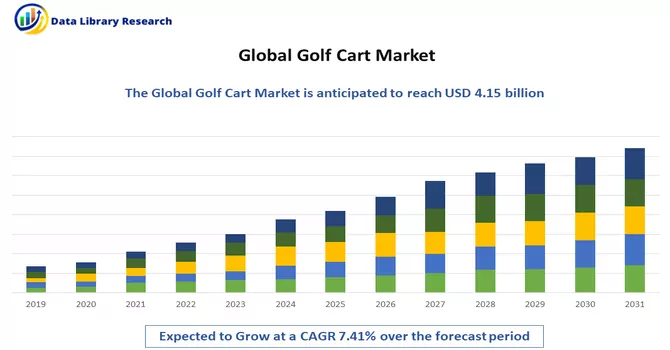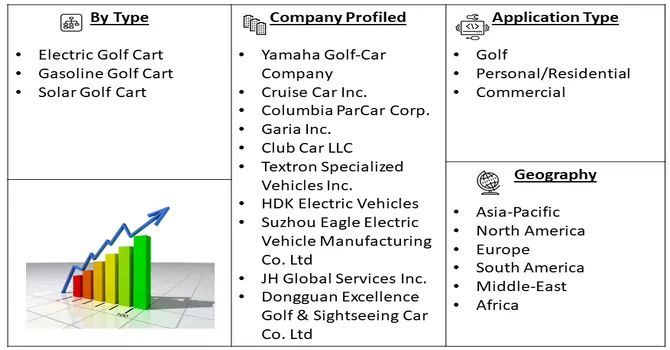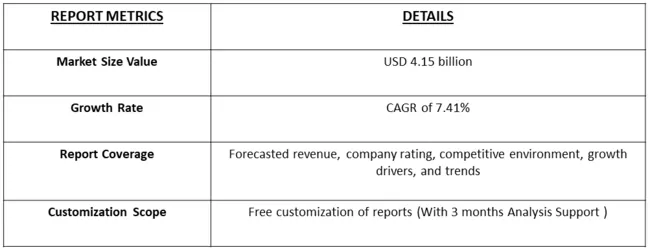The Golf Cart Market size is estimated at USD 4.15 billion in 2023 and is expected to reach a CAGR of 7.41% during the forecast period, 2024-2031.

Get Complete Analysis Of The Report - Download Free Sample PDF
A golf cart is a small, motorized vehicle designed for transporting golfers and their equipment around a golf course. Typically powered by electric batteries or gas engines, golf carts are compact, open-air vehicles featuring a flat platform to carry golf bags and seating for passengers. Widely used in the leisure and hospitality industry, golf carts have evolved beyond the golf course and are now utilized in various settings such as resorts, communities, and industrial facilities for short-distance transportation. Their ease of manoeuvrability, low-speed capabilities, and environmentally friendly electric models make golf carts a versatile and convenient mode of transportation for both recreational and practical purposes.
The golf cart market is driven by several key factors contributing to its growth. Firstly, the increasing popularity of golf as a recreational activity and the expansion of golf courses worldwide have significantly boosted the demand for golf carts. Additionally, the rising trend of golf tourism and the establishment of golf resorts and communities further propel the market. The growing awareness of environmental sustainability has led to an increased preference for electric golf carts, driven by their eco-friendly and low-maintenance characteristics. Furthermore, the utility of golf carts beyond the golf course, such as in residential communities, airports, and industrial facilities, broadens their market appeal. Technological advancements, including features like GPS navigation and entertainment systems, enhance the overall golf cart experience, appealing to a wider consumer base. As urbanization continues, the need for efficient and convenient short-distance transportation within communities contributes to the expanding market for golf carts. Overall, these factors collectively drive the growth of the golf cart market globally.
The golf cart market is witnessing several noteworthy trends that are shaping its trajectory. Firstly, there is a discernible shift towards electric golf carts, driven by the increasing emphasis on sustainability and environmental consciousness. Integration of advanced technologies is another prominent trend, with the incorporation of features like GPS navigation systems, Bluetooth connectivity, and enhanced entertainment options, enhancing the overall user experience. Beyond traditional golf course applications, there is a growing trend of utilizing golf carts for personal transportation in residential communities and recreational areas. Customization is gaining importance as consumers seek personalized designs, colors, and accessories for their golf carts. The advent of autonomous and self-driving golf carts also represents a futuristic trend, showcasing the industry's commitment to innovation. As golf continues to evolve as both a sport and recreational activity, the golf cart market adapts to these trends, offering diverse and sophisticated options to cater to the evolving needs and preferences of consumers.
Market Segmentation: The Report Covers Golf Cart Manufacturers and the Market is segmented by Type (Electric Golf Cart, Gasoline Golf Cart, and Solar Golf Cart), Application Type (Golf, Personal/Residential, and Commercial), and Geography(North America, Europe, Asia-Pacific and Rest of the World). The report offers market size and forecasts in terms of value (USD million) for all the above segments.

For Detailed Market Segmentation - Download Free Sample PDF
Market Drivers:
Increasing popularity of golf as a recreational activity globally
The burgeoning global popularity of golf as a recreational activity has significantly propelled the golf cart market into a phase of notable growth and expansion. As more individuals embrace golf for leisure and sporting purposes, the demand for golf carts, integral to the golfing experience, has witnessed a substantial upswing. Golf's status as a globally recognized and enjoyed sport has led to an increased number of golf courses and facilities worldwide. This surge in golf infrastructure directly correlates with the escalating need for golf carts, essential for efficiently navigating expansive courses and enhancing the overall golfing experience. Moreover, the evolving trend of golf tourism, with enthusiasts exploring renowned golf destinations, further amplifies the demand for golf carts. Resorts and golf communities are increasingly integrating these vehicles to offer convenience and mobility to players, contributing to the market's growth. The adoption of electric golf carts, driven by environmental consciousness and sustainability goals, adds another layer to this dynamic landscape. As the golfing community continues to expand globally, the golf cart market stands poised for sustained growth, catering not only to avid golfers but also finding utility in various leisure and hospitality settings beyond the golf course. The intersection of recreational trends and technological advancements positions the golf cart market as a thriving sector in the broader landscape of leisure and transportation solutions.
The broader utility of golf carts beyond golf courses
Beyond their traditional role on golf courses, golf carts have evolved into versatile vehicles with a broad spectrum of utility. These compact, electric or gas-powered carts have found applications in diverse settings, contributing to their increasing popularity. In recreational communities and resorts, golf carts serve as convenient modes of transportation, offering residents and visitors an efficient and environmentally friendly way to navigate expansive grounds. Their use extends to industrial facilities, airports, and event venues, where they provide a practical solution for short-distance transport of personnel and equipment. Furthermore, the adoption of golf carts in urban and suburban neighborhoods has become a notable trend. Residents utilize golf carts for local commuting, running errands, and exploring their communities, contributing to a more sustainable and leisurely lifestyle. The electric variants, in particular, align with eco-conscious initiatives, offering a quieter and emission-free alternative to traditional vehicles. Beyond practical applications, customized and modified golf carts have become a form of personal expression and recreation. Individuals often invest in personalized golf carts, equipped with unique designs, colors, and accessories, showcasing a blend of functionality and style. This broader utility of golf carts underscores their adaptability to various environments, making them not just a conveyance on the golf course but a versatile solution in diverse settings and a symbol of modern, eco-friendly transportation.
Market Restraints:
Safety Concerns
The exposed structure of conventional golf carts poses safety challenges, especially in areas with diverse vehicular traffic. To enhance their suitability for broader applications, it becomes imperative to address these safety concerns by implementing additional safety features. This may involve integrating advanced safety technologies such as collision detection systems, enhanced braking mechanisms, and the incorporation of protective elements to mitigate potential risks. By fortifying the safety aspects of traditional golf carts, particularly in environments shared with other vehicles, manufacturers can enhance their appeal and expand their usage beyond golf courses. This proactive approach not only addresses safety apprehensions but also aligns with evolving standards for urban and suburban transportation solutions. Emphasizing the commitment to safety and incorporating modern safety enhancements ensures that golf carts become more adaptable and secure for use in various settings, fostering their integration into diverse transportation ecosystems.
Segmental Analysis:
Electric Golf Cart Segment is Expected to Witness Significant Growth over the Forecast Period
The growing use of electric golf carts signifies a notable shift towards sustainable and eco-friendly transportation solutions. Electric golf carts have gained prominence due to their low environmental impact, offering a clean and quiet alternative to traditional gas-powered vehicles. As awareness of environmental sustainability increases, golf courses, resorts, and communities are increasingly adopting electric golf carts to minimize carbon footprints and reduce noise pollution. Beyond golfing environments, the electric golf cart's appeal extends to urban and suburban settings where communities prioritize green initiatives. The ease of recharging, lower operational costs, and advancements in battery technology contribute to the rising popularity of electric golf carts, making them a preferred choice for short-distance transportation. This trend reflects a broader societal move towards embracing electric mobility options and underscores the versatility of electric golf carts in meeting the evolving needs of environmentally conscious consumers across various recreational, residential, and industrial settings.
Commercial Segment is Expected to Witness Significant Growth over the Forecast Period
The expanding commercial applications of golf carts exemplify their versatility and efficiency in various sectors. Beyond their traditional use on golf courses, golf carts are increasingly finding utility in commercial settings. In hospitality, resorts, and theme parks, electric golf carts serve as convenient and eco-friendly modes of transportation for guests, enhancing overall visitor experience. Airports utilize golf carts for passenger and luggage transport within terminals and parking areas. In industrial facilities and warehouses, golf carts are employed for efficient material handling, enabling quick and nimble movement in confined spaces. Shopping complexes and large event venues deploy golf carts for on-site transportation, providing a convenient and sustainable solution for patrons. Additionally, municipalities and facilities with expansive grounds use golf carts for maintenance and security patrols. The customization options and adaptability of golf carts make them suitable for a wide range of commercial applications, showcasing their versatility in providing cost-effective, low-emission, and practical transportation solutions in diverse business environments.
North America Region is Expected to Witness Significant Growth over the Forecast Period
North America plays a pivotal role in the thriving golf cart market, contributing to its growth and evolution. The region's extensive golf course infrastructure, coupled with a robust leisure and hospitality industry, fuels the demand for golf carts as essential vehicles for navigating expansive courses. Beyond golf, North America embraces the broader utility of golf carts, utilizing them in various settings such as resorts, residential communities, and commercial complexes. The growing emphasis on sustainability aligns with the popularity of electric golf carts, contributing to their widespread adoption across the continent. Urban and suburban areas in North America witness a rising trend of using golf carts for short-distance transportation, creating niche markets for personal mobility solutions. Furthermore, the region's commitment to eco-friendly practices and green initiatives propels the use of electric golf carts in urban planning and community development. In commercial applications, airports, industrial facilities, and large venues leverage golf carts for efficient passenger transport, material handling, and on-site logistics. The North American golf cart market reflects a dynamic landscape driven by technological advancements, environmental consciousness, and the adaptability of these vehicles to diverse recreational and commercial needs. As a result, North America stands as a key contributor to the global golf cart market, shaping trends and driving innovation in the industry.

Get Complete Analysis Of The Report - Download Free Sample PDF
The analyzed market exhibits a high degree of fragmentation, primarily attributable to the presence of numerous players operating on both a global and regional scale. The competitive landscape is characterized by a diverse array of companies, each contributing to the overall market dynamics. This fragmentation arises from the existence of specialized solution providers, established industry players, and emerging entrants, all vying for market share. The diversity in market participants is underscored by the adoption of various strategies aimed at expanding the company presence. On a global scale, companies within the studied market are strategically positioning themselves through aggressive expansion initiatives. This often involves entering new geographical regions, targeting untapped markets, and establishing a robust global footprint. The pursuit of global expansion is driven by the recognition of diverse market opportunities and the desire to capitalize on emerging trends and demands across different regions. Simultaneously, at the regional level, companies are tailoring their approaches to align with local market dynamics. Regional players are leveraging their understanding of specific market nuances, regulatory environments, and consumer preferences to gain a competitive edge. This regional focus allows companies to cater to the unique needs of local clientele, fostering stronger market penetration. To navigate the complexities of the fragmented market, companies are implementing a range of strategies. These strategies include investments in research and development to stay at the forefront of technological advancements, mergers and acquisitions to consolidate market share, strategic partnerships for synergies, and innovation to differentiate products and services. The adoption of such multifaceted strategies reflects the competitive nature of the market, with participants continually seeking avenues for growth and sustainability. In essence, the high fragmentation in the studied market not only signifies the diversity of players but also underscores the dynamism and competitiveness that drive ongoing strategic maneuvers. As companies explore various avenues for expansion, the market continues to evolve, presenting both challenges and opportunities for industry stakeholders.
Key market players and companies working in the studied segment are:
Recent Developments:
1) In October 2021, Kinetic Green Energy & Power Solutions Ltd, an electric vehicle manufacturer in India, forged a strategic collaboration with the renowned luxury car brand Lamborghini to manufacture golf carts designed in Italy but produced in India. This joint venture is specifically targeted at the global market, aiming to combine Italian design aesthetics with Indian manufacturing expertise. The ambitious venture is poised to position Kinetic Green as a key player in the golf cart market, with projections indicating significant sales by 2022.
2) In August 2021, Club Car, a prominent golf and utility vehicle manufacturer, announced a partnership with ezLocator, a leader in daily pin placement management for golf courses. This collaboration introduces a cutting-edge integration that allows golfers to seamlessly access precise yardages through the cloud, enhancing the overall golfing experience. The partnership signifies a commitment to technological innovation within the golf industry, providing golfers with advanced tools for improved precision and enjoyment on the course.
Q1. What was the Golf Cart Market size in 2023?
As per Data Library Research the Golf Cart Market size is estimated at USD 4.15 billion in 2023.
Q2. At what CAGR is the Golf Cart market projected to grow within the forecast period?
Golf Cart Market is expected to reach a CAGR of 7.41% during the forecast period.
Q3. What are the factors driving the Golf Cart market?
Key factors that are driving the growth include the Increasing popularity of golf as a recreational activity globally and The broader utility of golf carts beyond golf courses.
Q4. What segments are covered in the Golf Cart market Report?
By Type, By Application And Geography these segments are covered in the Golf Cart market Report.
Data Library Research are conducted by industry experts who offer insight on industry structure, market segmentations technology assessment and competitive landscape (CL), and penetration, as well as on emerging trends. Their analysis is based on primary interviews (~ 80%) and secondary research (~ 20%) as well as years of professional expertise in their respective industries. Adding to this, by analysing historical trends and current market positions, our analysts predict where the market will be headed for the next five years. Furthermore, the varying trends of segment & categories geographically presented are also studied and the estimated based on the primary & secondary research.
In this particular report from the supply side Data Library Research has conducted primary surveys (interviews) with the key level executives (VP, CEO’s, Marketing Director, Business Development Manager and SOFT) of the companies that active & prominent as well as the midsized organization
FIGURE 1: DLR RESEARH PROCESS

Extensive primary research was conducted to gain a deeper insight of the market and industry performance. The analysis is based on both primary and secondary research as well as years of professional expertise in the respective industries.
In addition to analysing current and historical trends, our analysts predict where the market is headed over the next five years.
It varies by segment for these categories geographically presented in the list of market tables. Speaking about this particular report we have conducted primary surveys (interviews) with the key level executives (VP, CEO’s, Marketing Director, Business Development Manager and many more) of the major players active in the market.
Secondary ResearchSecondary research was mainly used to collect and identify information useful for the extensive, technical, market-oriented, and Friend’s study of the Global Extra Neutral Alcohol. It was also used to obtain key information about major players, market classification and segmentation according to the industry trends, geographical markets, and developments related to the market and technology perspectives. For this study, analysts have gathered information from various credible sources, such as annual reports, sec filings, journals, white papers, SOFT presentations, and company web sites.
Market Size EstimationBoth, top-down and bottom-up approaches were used to estimate and validate the size of the Global market and to estimate the size of various other dependent submarkets in the overall Extra Neutral Alcohol. The key players in the market were identified through secondary research and their market contributions in the respective geographies were determined through primary and secondary research.
Forecast Model
